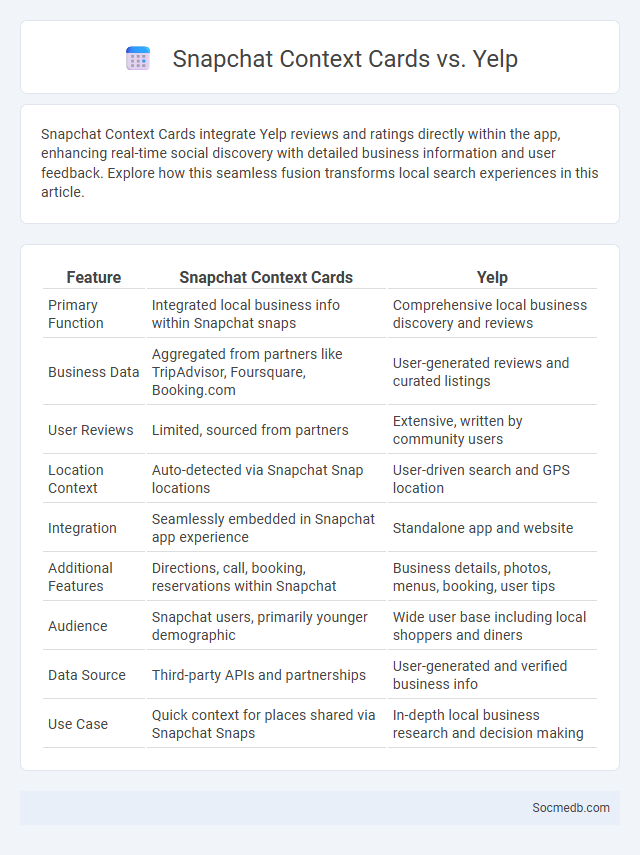
Photo illustration: Snapchat Context Cards vs Yelp
Snapchat Context Cards integrate Yelp reviews and ratings directly within the app, enhancing real-time social discovery with detailed business information and user feedback. Explore how this seamless fusion transforms local search experiences in this article.
Table of Comparison
| Feature | Snapchat Context Cards | Yelp |
|---|---|---|
| Primary Function | Integrated local business info within Snapchat snaps | Comprehensive local business discovery and reviews |
| Business Data | Aggregated from partners like TripAdvisor, Foursquare, Booking.com | User-generated reviews and curated listings |
| User Reviews | Limited, sourced from partners | Extensive, written by community users |
| Location Context | Auto-detected via Snapchat Snap locations | User-driven search and GPS location |
| Integration | Seamlessly embedded in Snapchat app experience | Standalone app and website |
| Additional Features | Directions, call, booking, reservations within Snapchat | Business details, photos, menus, booking, user tips |
| Audience | Snapchat users, primarily younger demographic | Wide user base including local shoppers and diners |
| Data Source | Third-party APIs and partnerships | User-generated and verified business info |
| Use Case | Quick context for places shared via Snapchat Snaps | In-depth local business research and decision making |
Introduction to Snapchat Context Cards
Snapchat Context Cards enhance user experience by providing detailed information tied to snaps, such as nearby locations, business ratings, and user reviews. These interactive cards integrate seamlessly with Snaps, offering quick access to hours, directions, and contact details without leaving the app. By combining real-time social content with contextual data, Snapchat Context Cards enable users to explore and engage with local places and events directly through shared moments.
Overview of Yelp’s Core Features
Yelp's core features include user-generated reviews, ratings, and photos that help consumers make informed decisions about local businesses. You can explore detailed business information such as hours, menus, and contact details, while also utilizing features like reservation bookings and messaging. The platform's robust filtering and search options enhance your ability to find the best services tailored to your preferences.
What Are Context Cards?
Context Cards provide You with detailed information about social media links, offering transparency about the source before clicking. These cards enhance user experience by displaying key details such as profile descriptions, recent activity, or credibility indicators directly within platforms like Twitter. By understanding Context Cards, users can make informed decisions about engaging with shared content, boosting online trust and safety.
Key Differences: Snapchat Context Cards vs Yelp
Snapchat Context Cards provide real-time location-based insights and interactive content directly within the app, enhancing user engagement through immersive experiences like reviews, contact details, and directions. Yelp specializes in comprehensive business listings and user-generated reviews, offering detailed ratings and extensive feedback to influence consumer decisions. Your choice depends on whether you seek dynamic, social-media-driven engagement or in-depth, review-based business information.
User Experience Comparison
Social media platforms differ significantly in user experience, with factors such as interface design, content personalization, and interaction methods shaping how you engage. Instagram prioritizes visual content and intuitive navigation, while Twitter emphasizes real-time updates and concise communication. Facebook offers comprehensive features combining social networking, groups, and marketplace, tailoring experiences based on your behavior and preferences.
Business Integration and Partnerships
Social media platforms offer powerful tools for business integration and partnerships, enabling seamless collaboration and real-time communication between brands. Leveraging APIs and cross-platform functionalities enhances marketing strategies, customer engagement, and joint ventures. Your business can expand its reach and operational efficiency by strategically aligning with social media ecosystems to create meaningful partnerships.
Information Accuracy and Real-Time Updates
Social media platforms prioritize information accuracy by implementing fact-checking mechanisms and using AI algorithms to filter out misinformation. Real-time updates enable users to access the latest news and events instantly, facilitating timely decision-making and awareness. Enhanced verification processes and live content streaming reinforce the credibility and immediacy of shared information across digital networks.
Social Engagement and Sharing Capabilities
Social engagement on social media platforms drives user interaction through comments, likes, and shares, fostering community building and brand loyalty. Advanced sharing capabilities enable seamless content distribution across multiple networks, amplifying reach and increasing visibility. Analytics tools track engagement metrics, providing valuable insights for optimizing content strategies and enhancing audience targeting.
Mobile Optimization and Accessibility
Mobile optimization is crucial for social media platforms to ensure fast loading times, responsive design, and seamless user experiences across diverse devices. Accessibility standards like screen reader compatibility, voice commands, and adjustable text sizes enhance social media inclusivity for users with disabilities. Implementing these features boosts engagement rates and expands reach within the increasingly mobile-dependent global audience.
Which Platform Wins: Snapchat Context Cards vs Yelp vs Generic Context Cards
Snapchat Context Cards offer location-based social insights directly within the app, enhancing user engagement through integrated maps, reviews, and contact details, outperforming generic context cards that provide limited interaction. Yelp dominates with comprehensive user-generated reviews and extensive local business data, making it the preferred platform for in-depth decision-making and discovery. While generic context cards serve basic informational purposes, Snapchat Context Cards and Yelp deliver richer, more interactive experiences tailored to real-time user context and trusted community feedback.
 socmedb.com
socmedb.com